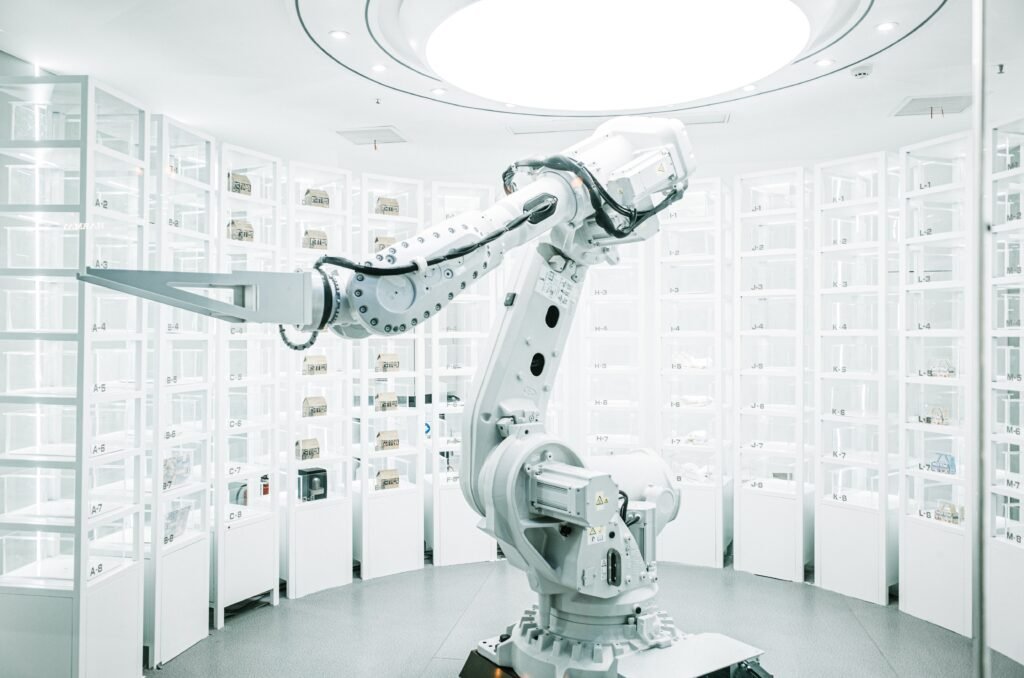Artificial Intelligence (AI) has become an increasingly prominent tool in today’s technological landscape. From virtual assistants like Siri and Alexa to advanced data analytics and machine learning algorithms, AI has revolutionized various industries. But how exactly do you harness the power of AI? In this article, we will explore the practical applications of artificial intelligence, highlighting how it assists in enhancing efficiency, improving decision-making processes, and automating tasks across different sectors. Whether you are a business owner, a scientist, or simply someone curious about the fascinating world of AI, this article will provide you with valuable insights on how to effectively utilize artificial intelligence in your day-to-day activities.
Understanding Artificial Intelligence
What is artificial intelligence?
Artificial intelligence (AI) is a branch of computer science that focuses on creating intelligent machines that can perform tasks that would typically require human intelligence. It involves developing algorithms and models that enable machines to learn, reason, and make decisions similar to humans.
Types of artificial intelligence
There are different types of artificial intelligence that vary in their capabilities and functionalities. These include:
-
Narrow AI: Narrow AI, also known as weak AI, is designed to perform specific tasks or solve specific problems. Examples include voice assistants like Amazon Alexa or Apple Siri, which can answer questions and perform actions based on voice commands.
-
General AI: General AI, also known as strong AI or human-level AI, possesses human-like intelligence and can understand or learn any intellectual task that a human being can do. However, the development of true general AI is still a topic of ongoing research.
-
Superintelligent AI: Superintelligent AI refers to an AI system that surpasses human intelligence in virtually every aspect. Its capabilities are hypothetical, and its potential impact on society is a subject of both excitement and concerns.
The importance of artificial intelligence
Artificial intelligence has become increasingly important in today’s world due to its wide-ranging applications and potential benefits. AI technology has the ability to revolutionize various industries, enhance productivity, enable automation, and improve decision-making processes.
Applications of artificial intelligence
Artificial intelligence has found applications in numerous domains. Some common areas where AI is extensively used include:
-
Healthcare: AI can assist in medical imaging analysis, drug discovery, personalized medicine, health monitoring, and diagnostics. It can improve patient care and support by providing accurate and timely insights.
-
Business: In the business sector, AI is used for customer service automation, process automation, data analysis, risk assessment, fraud detection, and predictive maintenance. It helps streamline operations and optimize business processes.
-
Education: AI is leveraged in adaptive learning platforms, intelligent tutoring systems, automated grading, personalized learning paths, and virtual reality-based education. It enhances the learning experience and enables personalized education.
-
Finance: AI is utilized in algorithmic trading, fraud detection, risk assessment, credit scoring, and financial planning. It improves efficiency, accuracy, and security in financial operations.
-
Transportation: In transportation, AI is applied to intelligent traffic management, autonomous vehicles, route optimization, vehicle diagnostics, and supply chain optimization. It enhances safety, efficiency, and sustainability in transportation systems.
How Artificial Intelligence Works
Machine learning
Machine learning is a subset of AI that involves the development of algorithms that allow systems to learn and improve from experience without being explicitly programmed. It relies on vast amounts of data to identify patterns, make predictions, or take actions.
Deep learning
Deep learning is a subfield of machine learning that focuses on artificial neural networks. These networks are inspired by the structure and function of the human brain. Deep learning algorithms can process complex data such as images, speech, and text, allowing for advanced recognition and understanding.
Natural language processing
Natural language processing (NLP) enables machines to understand and interpret human language. It involves techniques such as text classification, sentiment analysis, and language translation. NLP is used in applications like chatbots, virtual assistants, and automated language processing systems.
Computer vision
Computer vision enables machines to analyze and understand visual data, such as images or videos. It involves tasks such as object detection, image recognition, and scene understanding. Computer vision is used in various fields, including autonomous vehicles, surveillance systems, and medical imaging analysis.
Robotics
Robotics combines AI, computer vision, and machine learning to create intelligent machines capable of performing physical tasks. Robots can be developed to perform complex functions, automate repetitive tasks, and assist humans in various industries like manufacturing, healthcare, and agriculture.

Implementing Artificial Intelligence
Data collection and preprocessing
Implementing AI starts with collecting and preprocessing data relevant to the task at hand. This involves gathering and organizing data from various sources, cleaning and transforming it to a suitable format, and ensuring its quality and integrity.
Developing AI algorithms
After data is collected, AI algorithms need to be developed. This involves selecting the appropriate machine learning or deep learning techniques, designing the architecture of neural networks, and training the models using the collected data. The algorithms are customized for specific tasks and objectives.
Choosing the right AI models
Choosing the right AI models is crucial for the success of the implementation. Model selection depends on the specific requirements, available data, and desired outcomes. There are numerous pre-trained models available that can be fine-tuned for specific tasks or custom models can be developed from scratch.
Training and fine-tuning the models
Once the models are chosen, they need to be trained using the collected data. This process involves feeding the data into the models, adjusting model parameters, and iteratively improving the model’s performance through techniques like backpropagation. Fine-tuning involves tweaking the models to improve accuracy and optimize performance.
Testing and evaluation
After training the models, they need to be tested and evaluated to ensure they perform as expected. Testing involves exposing the models to new or unseen data and assessing their performance metrics like accuracy, precision, recall, or F1 score. Evaluation helps identify any shortcomings or areas for improvement before deploying the AI system.
Different AI Tools and Technologies
Chatbots and virtual assistants
Chatbots and virtual assistants are AI-powered applications that simulate human conversation. They can answer questions, provide information, and perform certain tasks like scheduling appointments or placing orders. Chatbots and virtual assistants improve customer service and automate repetitive tasks.
Image and speech recognition
AI technologies like image and speech recognition enable machines to understand and interpret visual or auditory data. Image recognition is used in areas like facial recognition, object detection, and image classification. Speech recognition allows machines to convert spoken language into written text, enabling voice-controlled applications.
Predictive analytics
Predictive analytics leverages AI algorithms to analyze historical data and make predictions about future events or behaviors. It helps organizations forecast trends, identify patterns, or make informed decisions. Predictive analytics is used in areas like sales forecasting, demand planning, or risk assessment.
Recommendation systems
Recommendation systems use AI to suggest items or content that users might be interested in. These systems analyze user behavior, preferences, and historical data to provide personalized recommendations. Recommendation systems are commonly used in e-commerce platforms, streaming services, or content-based websites.
Autonomous vehicles
Autonomous vehicles, or self-driving cars, use AI technologies such as computer vision, machine learning, and robotics to navigate without human intervention. These vehicles rely on sensors, cameras, and AI algorithms to perceive the environment, recognize objects, and make decisions for safe and efficient driving.

AI in Business
Customer service automation
AI-powered chatbots and virtual assistants automate customer service processes, providing efficient and personalized support to customers. They can handle frequently asked questions, resolve simple queries, or escalate complex issues to human agents.
Process automation
AI can automate repetitive and time-consuming tasks in business processes, increasing efficiency and reducing errors. Robotic Process Automation (RPA) is a form of AI that allows software robots to perform rule-based, repetitive tasks, freeing up human employees to focus on higher-value work.
Data analysis and insights
AI enables businesses to analyze large volumes of data quickly and accurately. AI algorithms can identify patterns, trends, or anomalies in data, providing valuable insights for decision-making and strategic planning. Data analysis helps businesses understand customer behavior, optimize operations, or identify growth opportunities.
Risk assessment and fraud detection
AI algorithms can analyze data to identify patterns or indicators of potential risks or fraudulent activities. This helps organizations detect and prevent fraud, reduce financial losses, and maintain operational integrity. AI can analyze vast amounts of data in real-time, enabling quick and accurate risk assessment.
Predictive maintenance
AI can optimize maintenance processes by predicting when equipment or machinery is likely to fail. By monitoring and analyzing sensor data, AI algorithms can detect anomalies or patterns that indicate potential equipment failures. Predictive maintenance helps organizations minimize downtime, reduce costs, and maximize asset lifespan.
AI in Healthcare
Medical imaging analysis
AI algorithms can analyze medical images, such as X-rays, CT scans, or MRIs, to assist healthcare professionals in diagnosing and treating diseases. AI can detect abnormalities, assist in tumor detection, or improve image quality, enhancing the accuracy and efficiency of medical imaging analysis.
Drug discovery and development
AI is used in drug discovery and development processes to accelerate the identification of new compounds or potential treatments. AI algorithms can analyze vast amounts of data, including genetic information and drug databases, to identify potential candidates for drug discovery and optimize drug design.
Personalized medicine
AI enables personalized medicine by analyzing patient data, genetic information, and medical records to provide tailored treatment plans or recommendations. AI algorithms can identify patient-specific patterns or predict drug responses, enhancing patient care and improving treatment outcomes.
Health monitoring and diagnostics
AI-based wearable devices and monitoring systems can continuously collect and analyze patient data, providing real-time insights on health status. AI algorithms can detect abnormalities, monitor vital signs, or predict disease progression, enabling early intervention and remote patient monitoring.
Patient care and support
AI-powered virtual assistants or chatbots can provide personalized support and information to patients, answering their questions, scheduling appointments, or providing medication reminders. These tools enhance patient engagement and improve access to healthcare services.

AI in Education
Adaptive learning platforms
AI-based adaptive learning platforms personalize the learning experience to individual students’ needs and abilities. By analyzing student performance data, AI algorithms can dynamically adjust the curriculum, content, or pace of learning, ensuring optimal learning outcomes.
Intelligent tutoring systems
Intelligent tutoring systems use AI to provide personalized guidance and support to students. AI algorithms can analyze student responses, track their progress, and provide tailored feedback or additional resources. Intelligent tutoring systems enhance student engagement and facilitate mastery of complex subjects.
Automated grading and feedback
AI can automate the grading process, providing immediate feedback to students and saving teachers’ time. AI algorithms can analyze student answers, assess their performance, and provide detailed feedback or suggestions for improvement. Automated grading helps efficiently manage assessments and enables timely feedback.
Personalized learning paths
AI can create personalized learning paths for students based on their individual learning needs and objectives. By analyzing student data and performance, AI algorithms can recommend suitable learning resources, activities, or assignments. Personalized learning paths cater to students’ unique learning styles and preferences.
Virtual reality in education
AI-powered virtual reality (VR) technologies offer immersive learning experiences in various subjects. AI algorithms can simulate realistic environments, allowing students to practice skills, conduct virtual experiments, or explore virtual worlds. VR in education enhances student engagement and promotes active learning.
AI in Finance
Algorithmic trading
AI algorithms are used in algorithmic trading to execute large volumes of trades at high speeds. AI analyzes market data, identifies patterns, and makes trading decisions based on predefined rules or strategies. Algorithmic trading improves efficiency and accuracy in financial market operations.
Fraud detection and prevention
AI can analyze vast amounts of financial data to detect patterns or anomalies that indicate fraudulent activities. AI algorithms can identify suspicious transactions, network behavior, or fraudulent claims, helping organizations prevent financial fraud and protect their assets.
Risk assessment and management
AI techniques can analyze historical data, market trends, or economic indicators to assess and manage financial risks. AI algorithms can predict market volatility, evaluate creditworthiness, or identify potential investment risks, assisting organizations in making informed decisions and minimizing financial losses.
Credit scoring
AI-powered credit scoring models can assess an individual’s creditworthiness based on various data points. AI algorithms analyze credit history, income, demographics, or behavioral data to determine creditworthiness and assign risk scores. Credit scoring models enable accurate and efficient credit decision-making.
Financial planning and recommendation
AI can provide personalized financial planning advice and recommendations based on an individual’s financial goals, risk tolerance, and financial situation. AI algorithms analyze financial data, investment trends, and market conditions to offer tailored recommendations, helping individuals make informed financial decisions.
AI in Transportation
Intelligent traffic management
AI is used for intelligent traffic management systems that monitor, analyze, and optimize traffic flow. AI algorithms can detect congestion, predict traffic patterns, and adjust traffic signals or route guidance systems to minimize congestion and improve traffic efficiency.
Autonomous vehicles and drones
Autonomous vehicles and drones use AI technologies like computer vision and machine learning to navigate and make decisions independently. AI algorithms analyze sensor data, identify objects, and make real-time decisions for safe and efficient transportation. Autonomous vehicles have the potential to transform mobility and logistics.
Route optimization
AI algorithms can optimize route planning and scheduling for logistics and transportation. By analyzing various factors such as distance, traffic conditions, or delivery time windows, AI can determine the most efficient routes for delivery or transportation. Route optimization reduces costs and improves delivery efficiency.
Vehicle diagnostics and maintenance
AI-enabled systems can monitor and analyze vehicle sensor data to detect potential faults or maintenance needs. AI algorithms can predict equipment failures, recommend maintenance actions, or alert drivers or maintenance personnel. Vehicle diagnostics and maintenance optimize vehicle performance and reduce downtime.
Supply chain optimization
AI is used in supply chain management to optimize inventory levels, demand forecasting, or transportation logistics. AI algorithms can analyze historical sales data, market trends, and supplier information to optimize inventory replenishment, reduce stockouts, and improve overall supply chain efficiency.
Ethical Considerations of AI
Bias and fairness
AI algorithms can perpetuate biases present in the training data or reflect systemic biases in society. It is essential to address and mitigate biases to ensure fairness and minimize discrimination in AI systems. Regular audits, diverse training data, and ethical guidelines can help address bias issues.
Privacy and security
AI systems often rely on vast amounts of personal or sensitive data. It is crucial to prioritize privacy and security to protect individuals’ data from unauthorized access or misuse. Implementing robust data protection measures, encryption, and anonymization techniques help safeguard privacy.
Transparency and explainability
AI systems should be transparent and provide explanations for their decisions or recommendations. Explainability is crucial to understand how AI algorithms reach certain conclusions. Transparency promotes trust and helps identify and address potential biases or errors in AI systems.
Accountability and responsibility
As AI systems become more autonomous, it is crucial to define accountability and responsibility frameworks. Clear guidelines and regulations must be established to address issues like algorithmic accountability, liability, and ethical standards in AI development and deployment.
Human-AI collaboration
AI should be developed and deployed as a tool to augment human capabilities, rather than replace humans. Human-AI collaboration ensures that humans remain in control, make informed decisions, and retain ethical judgment. Building human-centered AI systems encourages responsible and beneficial use of AI technology.
In conclusion, artificial intelligence is a rapidly advancing field with numerous applications and potential benefits across various industries. Understanding how AI works, implementing AI systems effectively, and considering ethical considerations are essential for harnessing the full potential of artificial intelligence while ensuring its responsible and beneficial use for society.






